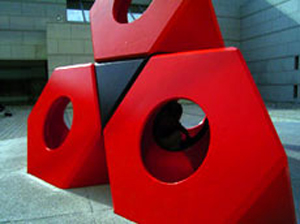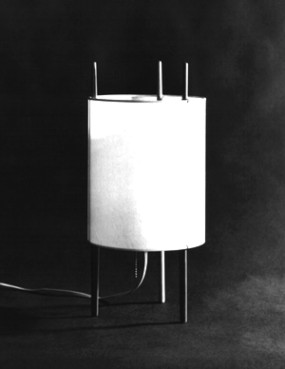Modernism Inside-Out
John Haberin New York City
The Noguchi Museum at Forty
Qi Baishi and Ruth Page
Starting fifty years ago, Isamu Noguchi pulled off a miracle. He turned a factory in Queens into a garden.
More precisely, it became the Noguchi Garden Museum and a tribute to one of Modernism's greatest sculptors. Costco had not yet come to the neighborhood, where a piano factory a quarter mile north still held sway. A motel on Broadway looked none too inviting, and Socrates Sculpture Park on the waterfront was little more than an untended patch of green. And still, with the museum's opening in 1985, three years before its creator's death, it brought a place for awakening and for peace. It has served ever since as a venue for Noguchi and often more. 
From studio to museum
New York art will always serve New Yorkers well, even if it takes a detour to see it all. The latest from the Public Art Fund brings sculpture to one of its most appealing sites, at a corner entrance to Central Park and across from the Plaza Hotel. It looks attractive, too, as First Sun—as does its subject, a woman's head with long, deep purple hair. Monira Al Qadiri allows her to hide behind a blue scarab mask, inspired by the tomb of Ramses I in Egypt. This sort of thing happens all the time in New York, even if you cannot say just who is hiding and from whom. Just be sure to give due time to a greater miracle for today.
Can the Noguchi Museum look half as miraculous today? Approaching its fortieth anniversary, it attempts something almost as daring. To celebrate the occasion, it rehangs the collection—nineteen galleries plus an actual sculpture garden. Amy Hau, its director since January 2024, asks to compete with Noguchi himself. He purchased the building across from his Astoria studio and took pains with every inch. As sales of his work rose and fell, he needed a place for what had become his private collection, and he wanted it to look just right.
He built just three rooms from scratch and adapted the rest to his art. Even now one can marvel at how factory interiors look so open, how sculpture blends into the garden, and how both turn the space inside-out. The museum (since an earlier renovation, simply the Noguchi Museum) reopened on a sweltering Thursday before Labor Day, in 2024, as a relief from summer and the claustrophobic gallery season about to begin. It was a chance, too, to shine without special exhibitions. Past shows have included Saburo Hasegawa and Christian Boltanski, along with Noguchi's hopes for a Memorial to the Atomic dead. Now it could reclaim the entire building for him alone.
Not everything has changed. His legacy may be daunting, but Noguchi was always an eager collaborator—on a Yale museum with Louis Kahn, the unfinished memorial to Hiroshima, city parks, and even a swimming pool. For him, play was indistinguishable from craft and art. And the rehanging is respectful enough, to the point that you may not notice a change. It may be a tad stricter in grouping sculpture by materials and forms. But then Noguchi can hardly help looking familiar whatever his survivors have done.
One enters to work from the 1970s, at his most memorable. Pockmarked surfaces bring out the weight of stone and give way to polished marble. As color enters, the lines of his sculpture turn on themselves without ever quite closing the circle. The second floor returns as ever to early work with more hints of figuration, including portrait busts, and gathers public projects. Allow me, then, to link to my first review of the Noguchi Museum and to invite you to read more. I continue here with exhibitions ten years ago of Noguchi's connections to calligraphy, costumes, and dance.
A Whitney retrospective that very year could not carry the same punch. Pieces looked like nothing more or less than, well, works of art. Where Jacques Derrida spoke of an artwork's frame as a supplement that undermines art's claim to finality, at the Whitney a sculpture's base appeared as just one more effort to remove a beautiful object from this world. Smaller rooms for his lamps looked like a brand-name designer's section of a department store. At his own museum, Noguchi erodes the very distinction between an art object and its surroundings. He sets his work free to enter the world.
From calligraphy to dance
There are places in New York where one goes to be alone. And then there are places one goes when one cannot bear to be alone. The Noguchi Museum is that rarity, as both. It is still outside the reach of guidebooks and critics, a healthy walk from the subway to the waterfront, and immeasurably far mentally even from Socrates Sculpture Park barely across the street. One enters around the block, rather than facing Costco. And the museum is still a built environment—one that Isamu Noguchi designed to the smallest detail to preserve his studio, his work, and his expressive repose.
 Noguchi did not worry whether mass would be too monumental, a vertical too masculine, or a cavity too feminine. It would be like worrying whether the rocks in Central Park are too grand a memorial to planet earth. He did not worry whether smooth surfaces are too polished, in stone sometimes imported all the way from Japan, or cut surfaces too close to expressionism. He did not worry whether a base is part of the work or even a base. He did not worry whether the walled garden, like its birch trees open to the sky, is inside the museum or out. Do Not Touch signs suggest that visitors have trouble distinguishing the benches from the arts, but also that they feel at home with both.
Noguchi did not worry whether mass would be too monumental, a vertical too masculine, or a cavity too feminine. It would be like worrying whether the rocks in Central Park are too grand a memorial to planet earth. He did not worry whether smooth surfaces are too polished, in stone sometimes imported all the way from Japan, or cut surfaces too close to expressionism. He did not worry whether a base is part of the work or even a base. He did not worry whether the walled garden, like its birch trees open to the sky, is inside the museum or out. Do Not Touch signs suggest that visitors have trouble distinguishing the benches from the arts, but also that they feel at home with both.
I came once more on an October day, nursing the pain and despair of a broken shoulder, a torn rotator cuff, surgery, and too many setbacks. I could neither work nor write, but I knew that I would not have to review the collection again, just take it in. I would not have to explain it even to myself. Noguchi thrives on contradictions, because he could trust in himself. By comparison, MoMA's atrium and sculpture garden are central plazas in a shopping mall. And two temporary exhibitions in Noguchi's garden museum anticipate something in his sculpture, that expressive repose, as "Space, Choreographed."
A boy from Japan who spent much of his teens in Indiana, where he was born, learned to deal with contradictions. While the museum describes him as mostly self-taught, Qi studied at a rather conservative New York school, assisted Brancusi in Paris, and thrived on collaborations. The two exhibitions make the most of them. Noguchi displays considerable stylistic consistency, and one tires of his supposed turning points. Still, anyone trying to make sense of his place between East and West will know that he was raised in California and visited Japan in 1931, while touring Asia with a friend, Buckminster Fuller. These two shows make the most of encounters shortly before and after.
On his way east, Noguchi stopped in Beijing, where a Japanese businessman and collector introduced him to a truly self-taught artist. Qi Baishi's adherence to tradition, along with Chinese tradition's esteem for copying and calligraphy, made him something between a guru, a folk artist, and a master. One artist knew no English, the other no Chinese, but Noguchi knew diplomacy, and somehow they got along. The museum's habit of using lists rather than wall labels makes the results look even more like a collaboration. In practice, Qi painted villages and nature, with a fair amount of writing, while the younger man focused on figure studies—curving in on themselves as dancers, warriors, lovers, or mother and child. He took away a renewed appreciation of drawing, a line's breadth and weight, and the human form.
Noguchi exhibited the "Peking drawings" on his return to the United States in 1932, when he started an even less-heralded collaboration, with Ruth Page. He worked with such noted choreographers as Martha Graham as well, but this brief encounter also involved a torrid affair. And it allowed him to apply his newfound interplay of brush and line to dance. Page looks at once ghostly and silly in his all-encompassing "sack dress," for Miss Expanding Universe. Noguchi and his bag lady also tackled the darkness in Edgar Allen Poe's "The Bells," but one might hardly notice the darkness. In their "tintinnabulation that so musically swells," the sketches are as mercurial as Poe's syncopated rhymes.

The Isamu Noguchi Museum reopened with a new hanging August 28, 2024, in anticipation of its fortieth anniversary. Qi Baishi and Ruth Page ran at the museum through January 26, 2014. I mention briefly "Isamu Noguchi: Master Sculptor," a retrospective at The Whitney Museum of American Art through January 16, 2005. Related reviews introduce Isamu Noguchi and revisit the Noguchi Museum for his encounters with Saburo Hasegawa and Christian Boltanski and for Monument to the Atomic Dead. Monira Al Qadiri ran at Doris C. Freeman Plaza through August 2, 2026.




